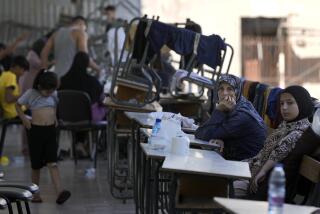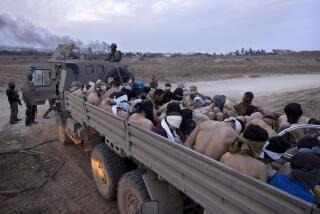Millions of Mines : Afghans Hit by a Deadly Calling Card
THAL, Pakistan — For more than half his life, 12-year-old Shawar Gul could not play outside the family hut in Jaji, Afghanistan. War was an unkind playmate.
Soviet helicopters strafed his village every week for nearly nine years. Artillery pounded into the fields like clockwork. Time and again, resistance fighters clashed with Afghan government troops, spraying machine-gun fire through the village.
But after nine long years of war, Jaji was liberated a few weeks ago. Soviet troops, who have been withdrawing from Afghanistan since May 15, abandoned their garrisons in the village near this Pakistani border town, leaving them for the moujahedeen resistance fighters to reclaim.
It Wasn’t a Butterfly
Shawar Gul finally went out to play last week, and it was only then that war took a direct part in the boy’s life. He was in the family vegetable garden when he spotted a shiny new plastic toy on the ground. It looked like a butterfly, Shawar recalled this week with a smile.
It wasn’t. It was a Soviet land mine disguised as a toy, and it blew off most of the boy’s left hand.
Shawar Gul is hardly alone. In his bed at the men’s ward of the American-financed Freedom Medicine Hospital here, he was surrounded by mine victims--limbless boys and moujahedeen fighters who are among the first in what doctors and military analysts here already say is an epidemic of newly war-wounded in Afghanistan: victims of land mines that are the latest brutal chapter in a war that has claimed 1.5 million lives.
Deadly Calling Cards
Like unwanted visitors leaving deadly calling cards, they report, withdrawing Soviet and Afghan government troops have been seeding the already devastated Afghan landscape with millions of land mines that will kill and maim an estimated 10,000 Afghan men, women and children in the months to come.
The mines are also the principal reason why few, if any, of the 3 million Afghan refugees who have been living for years in the squalor of Pakistani border camps are returning to their villages, despite the Soviet troop withdrawal.
“People are going to be blown up for the next 20 years in Afghanistan,” said one diplomat in Pakistan. “People are going to be killed. People are going to be maimed, and the civilians are going to take the brunt of it. The effect is going to be disastrous on the refugees when they return.”
U.S. military analysts have estimated that there are now between 3 million and 5 million land mines of various types scattered throughout Afghanistan. Many are old, planted many years ago by Soviet troops to form defense perimeters when they established outpost garrisons to fight the moujahedeen. Clearly, though, many more are recently planted and deliberately aimed at slowing the moujahedeen’s efforts to retake territory abandoned by the Soviets.
Doctors and aid workers on the border say that the purpose of planting the mines also is to maim Afghan civilians trying to re-establish villages, which resistance fighters can use as safe havens as they move closer to the Afghan capital of Kabul.
Diplomatic observers and independent, international refugee workers on the Afghan border added that their greatest concern is the seeding of mines like the one that blew off Shawar Gul’s left hand. Disguising mines as toys is not new; the numbers in which these and other mines are being dumped is, however.
“The biggest problem is that, in addition to mine-seeding around the abandoned garrisons, the mines are being found in vegetable gardens and fields, along village footpaths and in places where only civilians will go,” said one United Nations relief worker who asked not to be identified. “The U.N. has asked the Soviets about this, and we are told only that they have no maps indicating just where these mines are located. As anyone will tell you, this is going to be an enormous problem for us in the future as we try to resettle and reconstruct the Afghan nation.”
Border Hospitals
The absence of maps comes as no surprise to veteran aid workers like Robert Brenner, whose Honolulu-based Freedom Medicine Relief Agency for the past three years has been training Afghan moujahedeen as paramedics and operating the border surgical hospital in Thal where Shawar Gul and his fellow mine victims are being cared for.
“We know for a fact that the Soviets have been seeding all of these border villages and towns from helicopters for months,” said Brenner, who gathers information about the war from moujahedeen commanders and injured fighters at his hospital and has also started collecting samples of the mines and booby-traps. “They just toss them out the side of the helicopter, and wherever they fall, they fall.
“There are some that are like butterfly- or toy-mine variety. Others are designed to look like ballpoint pens. When you pick it up and press the top, it explodes.
“These devices are only meant for maiming--not to kill. If you maim a child, the whole family has to leave the village and go to the (refugee) camps in Pakistan, and there goes the support system for the moujahedeen. “
‘Ft. Freedom’
Brenner’s border hospital, which is financed half by the U.S. government and half by private donation, is something of a barometer of the current state of the war. Nicknamed Ft. Freedom, it runs ambulances across the border into Afghanistan, which collect the wounded within hours of their injuries.
In interviews this week, the patients--half of whom are mine victims--said Soviet forces also are using bombing sorties to slow the moujahedeen ‘ s recent progress. Resistance leaders said they have retaken at least 30 towns and 150 military command posts in the month since the Soviets started their withdrawal.
A resistance fighter in the emergency room, his body full of shrapnel, said that his village in the Chowni district near Jaji had been bombed by Soviet MIG fighter jets over the weekend, a few weeks after his unit had moved in.
“I was expecting this,” said the hospital’s chief surgeon, Dr. Hesham Mohammed Hashim, a prominent physician who fled Kabul in September, 1986, when the Afghan secret police learned that he secretly had been treating injured resistance fighters at the Kabul University Hospital.
Bombing Victims
“Before the last few days, it was mostly mine victims. But now we’re getting bombing victims as well. The regime (in Kabul) waited for people to go back to the villages, and then they started bombing.”
Still, Hashim said, it is the mine victims who continue to fill his surgical hospital, just 10 miles from Afghanistan. “At least one or two every night,” he said. “The mines are just everywhere now,” he said.
What is as striking as the human toll from the mines, though, is the attitude of the victims.
Just 24 hours after his right foot had been amputated after a mine blast, Abdul Rab, a 21-year-old moujahedeen fighter from the northern provinces of Afghanistan, was smiling in his hospital bed as he described the mine that also filled much of his body with shrapnel.
New Type of Explosives
“It was greenish-yellow in color and made of plastic,” he said, discussing his wounds strictly in the context of their military implications. “These are new ones. We are seeing these only in the last few weeks--these and the inverted grenades that are detonated by thin trip wires. We are trying to learn how to defuse these, but it will take time.”
Asked what he will do now that he has lost a foot, Rab appeared surprised by the question.
“Of course I will go back and fight,” he said, adding that two of his six brothers already have been killed in the war. “I will get an artificial foot and return to my moujahedeen unit within a month.”
For fighters like Rab, the Pakistani city of Peshawar is the next stop before returning to war. In the border capital of Pakistan’s Northwest Frontier, there is an artificial limb hospital run by the International Committee of the Red Cross that already has provided nearly 3,000 legs, arms, hands and feet to maimed Afghans, many of them within the last several months.
State-of-the-Art Limbs
There is also a private charitable clinic at a Peshawar hospital that makes almost state-of-the-art limbs for wounded Afghans. It is run by the Sandi Gall Foundation in London, and, although it has been open for just six months, the orthopedic workshop already has fitted new legs for 150 Afghan mine victims. Director Leslie Johnstone said he has 60 more on the waiting list.
“The best guess we have at the moment is that there will be something like 10,000 more mine victims. Whatever time frame for that will be (in) is anybody’s guess,” Johnstone said, as several of his patients hobbled through the hospital hallway on crutches.
“But one thing’s for sure. When you start looking at numbers like that, it’s hard to listen to these people who think the war in Afghanistan is nearly over.”
More to Read
Sign up for Essential California
The most important California stories and recommendations in your inbox every morning.
You may occasionally receive promotional content from the Los Angeles Times.










